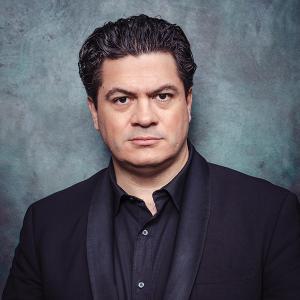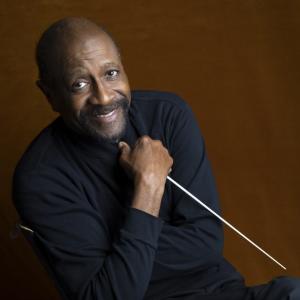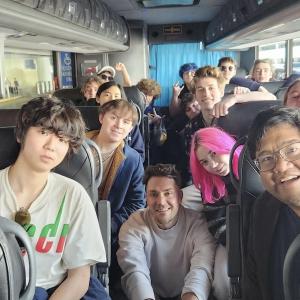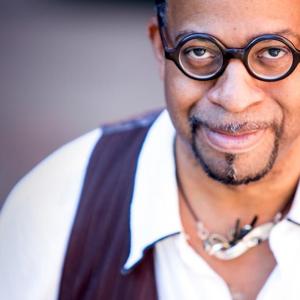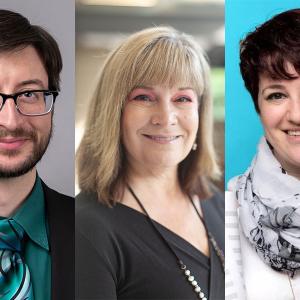Interlochen Online's next session begins May 6—enroll in any course or certificate program now.
Taking the arts online
Interlochen Arts Academy’s artistic faculty discuss the challenges and opportunities of teaching art online.

Nancy Stagnitta's flute studio holds a meeting over the Zoom video conferencing program.
Interlochen Center for the Arts founder Joseph Maddy was an innovator. While other educators clung to tried-and-true teaching strategies, Maddy was always searching for new methods and media.
One of Maddy’s chief interests was radio. In the 1920s, when many classical musicians criticized the medium for its poor sound quality, Maddy recognized the potential of radio and installed a broadcast booth in the Interlochen Bowl. Starting in 1930, the Sunday concerts of Interlochen’s Camp orchestra were broadcast across the country over the CBS and NBC radio networks. That same year, Maddy pioneered a series of educational radio programs that would enable musicians across the nation to study orchestral instruments from the comfort of their own homes.
Over the years, Maddy’s spirit of ingenuity and interest in emerging technologies became embedded in the culture of the institution he founded. This spring, as the spread of COVID-19 has forced many schools to adopt distance learning, Interlochen Arts Academy is at the cutting edge of these efforts. On April 6, Arts Academy classes—both artistic and academic—resumed via digital platforms.
“We are using all available resources and the collective energy of our faculty to continue to provide meaningful artistic experiences for both our students and our community,” said Camille Colatosti, Provost of Interlochen Center for the Arts.
The Academy’s digital exploration began several years ago, when the institution implemented an online learning management system. This fall, the campus adopted a new system, Canvas, which has become the core of both academic and artistic learning during this off-campus interval.
“We’re fortunate to have made the switch to Canvas this year, as it’s a very robust learning management system,” said Lesley Tye (IAA 90-93), an instructor of both Creative Writing and Film and New Media. “Canvas allows for online discussions, conferences, and file sharing, all of which will be critical for moving our coursework online.”
In addition to Canvas, faculty of all majors are experimenting with other software for communication and educational purposes. Nearly all faculty have integrated Zoom, a video conferencing platform, into their curriculum.
“We'll be using Zoom for all synchronous meetings,” Tye said. “The benefit of Zoom is that it allows students to join the call via phone if they have limited internet access.”
Zoom also facilitates private music instruction. “We are able to approximate the in-the-moment aspects of music teaching through Zoom,” said Instructor of Oboe Dane Philipsen. “While lags and disruptions in sound quality occur, we use shared digital recordings to work around them, in addition to pedagogical techniques like reviewing recordings more in this virtual environment.”
Nancy Stagnitta, the Academy’s instructor of flute, sees the lack of physical interaction during private lessons as a learning experience for students. “Being apart from my students will require them to be particularly astute in their ability to self-assess and correct, with my guidance. It will also require us to develop a broader vocabulary in order to deal with these issues,” Stagnitta said. “Ultimately, these shifts present a unique opportunity for growth.”
Zoom is also a critical tool for the theatre division. “At its essence, theatre is people gathering together to share stories with other people about what it means to be human,” said Director of Theatre Bill Church. “We are continuing to effectively build ensemble through Zoom.”
Beyond Canvas and Zoom, faculty are utilizing a wide variety of other tools to address major-specific needs. Tye and the Film and New Media program, for example, are taking advantage of screenwriting software Final Draft, which is offering free licenses for students during the COVID-19 crisis. Instructor of Percussion Keith Aleo (IAC 80-81, IAA 80-81) counts Pro Tools and Sibelius among his new curricular tools. Church and the theatre division are taking advantage of Drama Online and productions from the National Theatre, which are available through Interlochen’s Bonisteel Library.
With each student in possession of varied materials and resources at home, visual arts faculty are discovering new opportunities for artistic growth. “This shift into a multitude of locations means that we are adjusting assignments to more open-ended concepts that can be interpreted with whatever each student has in their living spaces and homes,” said Instructor of Drawing and Painting Conor Fagan “I think the result will be much more personalized, self-reflective art. It is very exciting!”
Fagan is also tapping into his own art practice as a means of connecting with his students. “I am drawing on my own artistic expressions to teach and communicate more fully with students in an online setting,” he said. “Even though we aren't physically together, we can have a fuller understanding of each other as artists.”
Across the board, instructors are adjusting curricular aims to maximize the off-campus learning experience. “This is an opportunity for us all to expand our experiences, and develop our art forms in new directions,” said Director of Choirs John Bragle, who recently composed a song dedicated to fellow music instructors who are pivoting to online teaching.
For Director of Dance Joseph Morrissey, virtual instruction is an opportunity to take a deep dive into process. “We are educating dance students about the ‘what’ they are actually physically doing,” he said. “Our focus is on the more theoretical and academic areas of dance, such as history, appreciation, and current cultural contexts. This allows students to think beyond the physical and more into the academic nature of the field and its longstanding impact and contribution to other performing arts.”
Similarly, theatre faculty are enhancing coursework with new theoretical and academic frameworks. “This may mean greater individual character analysis, research of playwrights, dramaturgical studies, or imaginative homework assignments and activities meant to keep each student fully invested in learning more about their chosen art form,” Church said. “Design and production students have additional individual work and some exciting guest artist opportunities that will be provided via video.”
Like Morrissey, Aleo is also focusing more on history, with an emphasis each week on a different percussion instrument. He’s also leveraging his personal connections to facilitate virtual master classes and lectures with professional percussionists from around the world.
“In any challenge there is a gift,” Aleo said. “Students are discovering a greater understanding of the historical aspects of percussion, creativity, and a further understanding of deep listening—things that we often miss in our normal curriculum.
“Institutionally, there is also an opportunity for us to learn from this experience, and to grow our online offerings,” Aleo said. “Wouldn't it be wonderful to bring the magic of Interlochen to everyone's home?”
